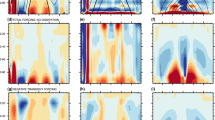Summary
The kinetic energy budget of the troposphere between equator and 60°N is studied on the basis of climatic mean data for the winter and summer seasons. The intense Hadley circulation during winter is an important producer of kinetic energy. Kinetic energy generation within the domain of the Hadley cell exceeds the local frictional dissipation by about 20·1020 erg·sec−1. Transient eddy mechanisms are mainly responsible for the export from the northern portion of the Hadley cell poleward. The strong frictional dissipation within the extratropical cap and the energy consumption within the (indirect) Ferrel circulation are for about one third met by import across 30°N; about two-thirds of the local depletion appear to be supplied by kinetic energy generation associated with transient eddies, while the effect of standing eddies is found unimportant. Summer conditions are characterized by greatly decreased generation and dissipation rates; imports from the domaine of the Hadley cell become less important for the mainteance of circulation in the extratropical cap.
Zusammenfassung
Die kinetische Energie-Bilanz der Troposphäre zwischen Äquator und 60° N wird auf Grund klimatologischer Mittelwerte für die Winter- und Sommerjahreszeit untersucht. Die kräftige Hadley-Zirkulation im Winter spielt eine bedeutende Rolle in der Produktion von kinetischer Energie. Im Bereich der Hadley-Zelle übertrifft die Produktion die Vernichtung von kinetischer Energie um ungefähr 20·1020 erg·sec−1. Zeit-räumliche Störmechanismen, etwa in der Art wandernder Zyklonen, sind hauptsächlich verantwortlich für die Ausfuhr von der Nordflanke der Hadley-Zelle polwärts. Die starke Vernichtung von kinetischer Energie in außertropischen Breiten sowie der Energieverbrauch innerhalb der (indirekten) Ferrel-Zirkulation werden zu etwa einem Drittel durch Einfuhr von den Tropen ausgeglichen. Eine stark verminderte Produktion und Vernichtung von kinetischer Energie ist für die Sommerjahreszeit charakteristisch; die Energiezufuhr aus dem Bereich der Hadley-Zelle verliert dann an Bedeutung für die Aufrechterhaltung der Zirkulation in außertropischen Breiten.
Résumé
On examine ici le bilan de l'énergie cinétique de la troposphère entre l'équateur et le 60ème parallèle nord. Cette étude est faite pour l'hiver et l'été sur la base de moyennes climatologiques. La forte circulation de Hadley joue, en hiver, un rôle important dans la production d'énergie cinétique. Dans la région de la cellule de Hadley, la production d'énergie cinétique dépasse sa destruction d'environ 20·1020 erg·sec−1. Des mécanismes perturbateurs agissant aussi bien dans le temps que dans l'espace—comme par exemple les cyclones mobiles—sont les principaux agents responsables des transports du flanc nord des cellules de Hadley en direction du pôle. Les fortes destructions d'énergie cinétique dans les latitudes extra-tropicales comme la consommation d'énergie à l'intérieur de la circulation (indirecte) de Ferrel sont compensées pour un tiers environ par un apport des tropiques. L'été est caractŕisé par une production et une destruction fortement réduites de l'énergie cinétique. Un apport de cette énergie de la région de la cellule de Hadley perd alors de son importance pour le maintien de la circulation aux latitudes extra-tropicales.
Similar content being viewed by others
References
Brunt, D.: Physical and Dynamical Meteorology. London: Cambridge University Press, 1939.
Hastenrath, S.: A Study of the Atmospheric Circulation between Equator and 60° N during the Winter and Summer Seasons. Pure Appl. Geoph.73, 123–142 (1969).
Hastenrath, S.: A Study of the Kinetic Energy Budget of the Troposphere over the Caribbean Sea and the Gulf of Mexico. Pure Appl. Geoph.68, 252–264 (1967).
Hastenrath, S.: A Study of the Atmospheric Energy Budget between Equator and 60° N during the Winter and Summer Seasons. Part I: The Latitude-Mean Conditions. Beitr. Phys. Atmosph. (in print).
Hasterrath, S.: A Study of the Atmospheric Energy Budget between Equator and 60° N during the Winter and Summer Seasons. Part II: The Regional Pattern. Beitr. Phys. Atmosph. (in print).
Holopainen, E. O.: On the Dissipation of Kinetic Energy in the Atmosphere. Tellus15, 26–32 (1963).
Holopainen, E. O.: On the Role of Mean Meridional Circulations in the Energy Balance of the Atmosphere. Tellus17, 285–294 (1965).
Kao, S. K.: The Meridional Transport of Kinetic Energy in the Atmosphere. J. Meteor.11, 351–361 (1954).
Kung, E. C.: Climatology of Aerodynamic Roughness Parameter and Energy Dissipation in the Planetary Boundary Layer of the Northern Hemisphere. Dept. Meteorology, University of Wisconsin, Annual Report 1963, Contract DA-36-039-AMC-00878, DA-Task 1-A-6-11001-B-021-08.
Kung, E. C.: Kinetic Energy Generation and Dissipation in the Large-scale Atmospheric Circulation. Mo. Wea. Rev.94, 67–82 (1966).
Mintz, Y.: The Total Energy Budget of the Atmosphere. Dept. Meteor., Univ. Calif. Los Angeles, Final Report, General Circulation Project, Paper No. 13, Contract AF 19(122)-48 (1955).
Oort, A. H.: On Estimates of the Atmospheric Energy Cycle. Mo. Wea. Rev.11, 483–493 (1964).
Palmén, E.: On the Maintenance of Kinetic Energy in the Atmosphere. The Rossby Memorial Volume. 212–224, New York, 1959.
Palmén, E.: On Generation and Frictional Dissipation of Kinetic Energy in the Atmosphere. Soc. Scient. Fennica, Commetations Phys. Math.24, 11 (1960).
Palmén, E., H. Riehl, andL. A. Vourela: On the Meridional Circulation and Release of Kinetic Energy in the Tropics. J. Meteor.15, 271–277 (1958).
Pisharoty, P. R.: The Kinetic Energy of the Atmosphere. Dept. Meteorology, UCLA, Scient. Rep. No. 6, Contract AF 19(122)-48 (1955).
Priestley, C. H. B.: Heat Transport and Zonal Stress between Latitudes. Quart. J. Roy. Meteor. Soc.75, 28–40 (1949).
Priestley, C. H. B.: Turbulent Transfer in the Lower Atmosphere. University of Chicago Press 1959.
Starr, V. P.: On the Production of Kinetic Energy in the Atmosphere, J. Meteor.5, 193–196 (1948).
Starr, V. P., andR. M. White: Schemes for the Study of Hemispheric Exchange. Processes. Quart. J. Roy. Meteor. Soc.78, 407–410 (1952).
Starr, V. P., andR. M. White: Balance Requirements of the General Circulation. Geophys. Res. Papers, No. 35, Air Force Cambridge Research Center, Cambridge, Mass., 1954.
White, R. M.: The Meridional Eddy Flux of Energy. Quart. J. Roy. Meteor. Soc.77, 189–199 (1951).
Author information
Authors and Affiliations
Additional information
With 3 Figures
Rights and permissions
About this article
Cite this article
Hastenrath, S. On the role of meridional circulations in the kinetic energy budget of the northern Hemisphere. Arch. Met. Geoph. Biokl. A. 18, 1–16 (1969). https://doi.org/10.1007/BF02247860
Received:
Issue Date:
DOI: https://doi.org/10.1007/BF02247860




